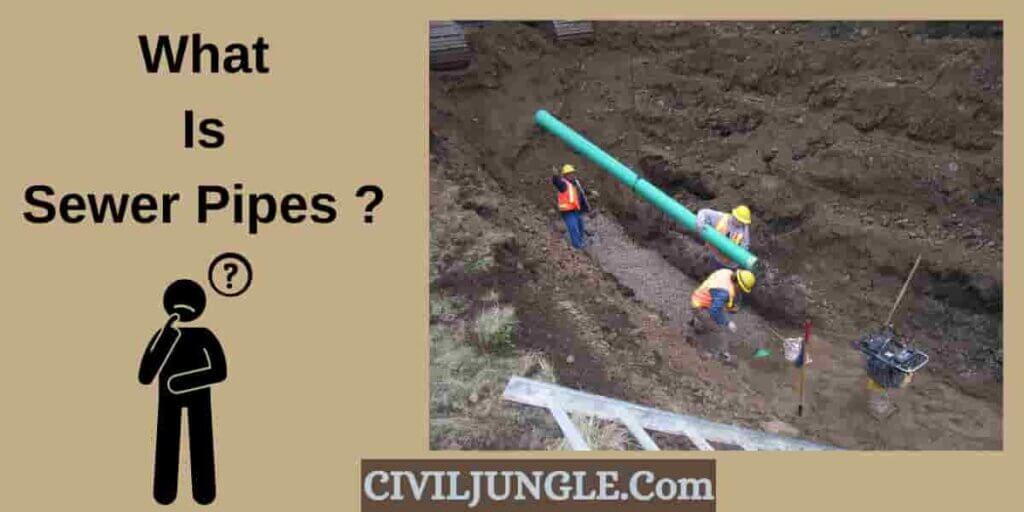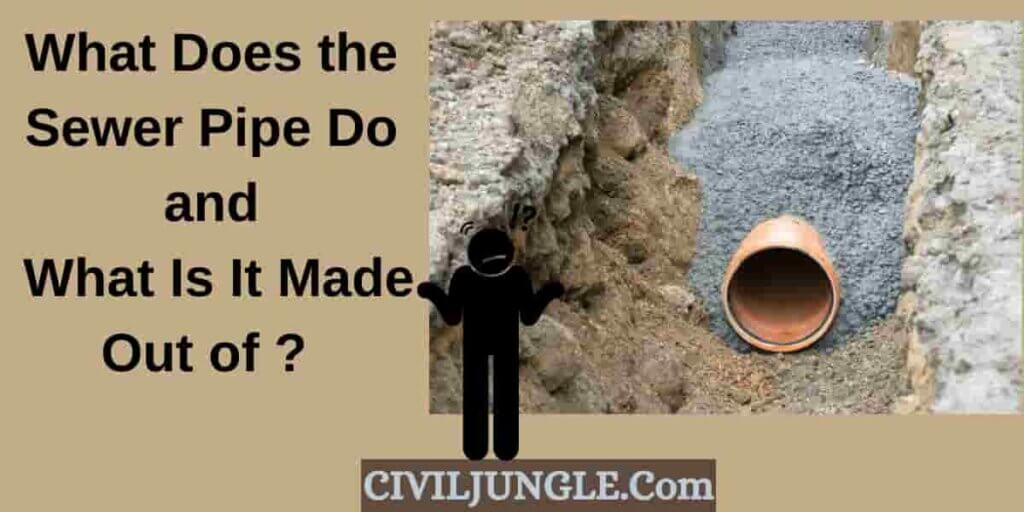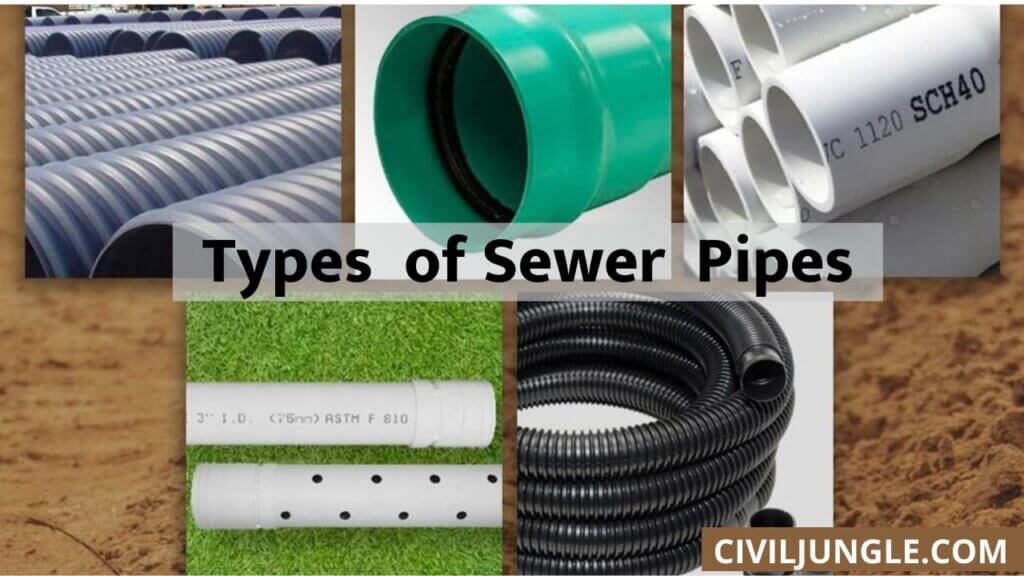What Is Sewer Pipes?

The pipes are used for transporting water or wastewater from the home or the industrial area outside, which is called sewer pipes. We have to provide special care to the sewer pipe because it can be broken or corrosion by the wastewater.
What Does the Sewer Pipe Do and What Is It Made Out of?

The sewer pipes do many works at your home; it is only one pipe that can easily transport all the wastes water from inside to your house to outside. The sewer pipes help to underneath the main road of your locality.
The sewer pipes are laying a few feet under the soil, which also provides a good clear space for the home and industrial owner. The different types of sewer pipes are used depending on the weather of the locality, and that also repair or replace or upgrade depending on the time.
The sewer pipes are made out of many types of material, which is used; depending on the weather of the locality where the pipes are used. The material that is also used for making out the sewer pipes is, PVC and ABS plastic, another is a mixture of wood and fibres, cast iron, clay, etc.
Types of Sewer Pipes
There are having many types of sewer pipes in the construction markets, which are below.
- PVC and ABS Sewer Pipe
- Cast Iron Sewer Pipe
- Clay Sewer Pipe
- Orangeburg Sewer Pipe
1. PVC and ABS Sewer Pipe

PVC and ABS sewer pipe is one type of plastic pipe, there PVC is white plastic pipe and another ABS is a black plastic pipe. For the solid waste matter this both black and white plastic pipes have a smooth interior part for carrying.
And simultaneously it has a smooth exterior part that also helps to prevent the anchorage of the tree roots. The diameter of the PVC and ABS plastic pipe is 4 inches and also it is very easy to use and easily available near the construction site.
Nowadays these types of pipes are most usable and inexpensive, easy to cut, and also this type of pipe is very lightweight. This type of plastic pipe also has another benefit that is it is also used with clay and cast-iron pipes.
2. Cast Iron Sewer Pipe

In older types of homes, this type of cast iron sewer pipe was generally used, but it is still used as a replacement pipe in the older house when an older house the old cast iron pipes are damaged.
The cast-iron pipes have a very good side, which is it has incredibly strong, compared to other sewer pipes that are available in the market.
In per linear foot of 4-inch diameter of cast iron pipe can withstand up to two tons of pressure, while the other types of pipes like ABS, PVC, and also clay pipes can be a break.
But the cast-iron pipes have a heavyweight and for this reason, it is not easily used on the construction site, and also it is not cut easily in the desired size. In the ground when you cut the cast iron pipe you have to need a soil pipe cutter that can be hired with some small fee supply house.
The cast iron pipe has a heavy advantage that is, it is non-flammable. For this above reason, the uses of the cast iron sewer pipe are decrees in day by day in new houses.
3. Clay Sewer Pipe

Clay sewer pipe is also used in sewer construction, but the uses of this clay sewer pipe became very few nowadays in sewer constructions. Compare to other sewer pipes, the clay sewer pipe is heavy and when you want to cut the pipe it becomes tricky.
But the clay sewer pipe has a disadvantage that is; it is not easily available in the market, because most retailers do not sell the clay sewer pipe.
But compare to plastic clay pipes it has a great advantage, that is, the clay sewer pipe has more chemical reaction resist power from the plastic pipe.
Another disadvantage of the clay sewer pipe is, it is easily cracked by the roots because it has more pores area so the tree roots easily entire into the pipe and result crack the pipe.
4. Orangeburg Sewer Pipe

The Orangeburg sewer pipe is not used in the current state, it is used in a collapsed state in construction. The Orangeburg sewer pipe was manufactured with a mixture of wood and fibres, and that is also called fibre conduit pipe.
The advantage of the sewer pipe is it is a water resistance pipe, to make it water-resistant adhesive is added to this pipe.
At this time in the plumbing system, the plumbers are used to like this type of pipe because this type of pipe is easy to carry for its lightweight and also cut into the desired size with a regular wood saw.
For proper installations of the fibre conduit pipe, this type of pipe at the first laying on a sand bed reduces the stress of installations. This Orangeburg pipe cannot be seen today in the plumbing system because the life span of this type of pipe is more than 50 years.
FAQ about Sewer Pipes
What Is a Sewer Pipe?
A sewer pipe is a pipe used to transport wastewater and waste from homes or industrial areas to a treatment facility or sewage system. It is crucial for maintaining sanitation and managing waste effectively.
What Materials Are Sewer Pipes Made From?
Sewer pipes are made from various materials, including:
- PVC (Polyvinyl Chloride)
- ABS (Acrylonitrile Butadiene Styrene)
- Cast Iron
- Clay
- Orangeburg (a mix of wood and fibers)
What Are the Different Types of Sewer Pipes and Their Uses?
- PVC and ABS Sewer Pipes: Lightweight, easy to install, and resistant to tree roots. Commonly used in modern construction.
- Cast Iron Sewer Pipes: Strong and durable, suitable for heavy loads, but heavier and harder to cut. Often used in older homes.
- Clay Sewer Pipes: Resistant to chemical reactions but prone to cracking from tree roots. Less common today.
- Orangeburg Sewer Pipes: Made from a mix of wood and fibers, these are outdated and rarely used today due to their limited lifespan.
How Do I Choose the Right Sewer Pipe for My Needs?
Choosing the right sewer pipe depends on factors such as:
- Local climate and weather conditions
- Soil type and installation environment
- Cost and availability of materials
- Durability and maintenance needs
How Can I Maintain Sewer Pipes?
Regular maintenance involves:
- Inspecting pipes for cracks or damage
- Clearing blockages and tree roots
- Repairing or replacing damaged sections
- Checking for signs of corrosion or wear
What Are the Signs That a Sewer Pipe Needs Repair or Replacement?
Signs include:
- Frequent blockages or slow drainage
- Unpleasant odors coming from drains
- Visible cracks or leaks in pipes
- Sinking or uneven ground above the pipe
Can I Install Sewer Pipes Myself?
While some sewer pipe installations can be done DIY, it’s often recommended to hire a professional plumber, especially for complex or large-scale installations, to ensure compliance with local codes and standards.
How Long Do Sewer Pipes Typically Last?
The lifespan of sewer pipes varies by material:
- PVC and ABS: 25-50 years
- Cast Iron: 50-100 years
- Clay: 50-100 years
- Orangeburg: 50 years or less
Are There Environmental Considerations for Sewer Pipes?
Yes, choosing sustainable materials and ensuring proper installation and maintenance can reduce environmental impact. Replacing old or damaged pipes promptly helps prevent leaks and contamination.
What Should I Do If I Encounter a Sewer Pipe Problem?
Contact a licensed plumber or sewer specialist to diagnose and address the issue. Prompt action can prevent further damage and costly repairs.


